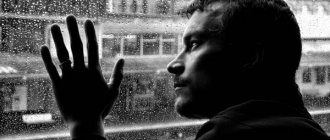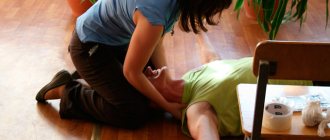There are simply no people in the world who do not have disturbing and extremely unpleasant thoughts for at least a few minutes. These fleeting anxieties do not interfere in any way at work or at home, and do not force you to change your lifestyle, behavior, or habits. Obsessive thoughts (obsessions) are something similar to anxious thoughts, but they are also fundamentally different. Obsessions are a subtype of anxious thoughts that take over the brain, but in the case of this disease we are talking about a long-term and involuntary appearance of anxiety. It is extremely difficult to cope with them on your own. And even with professional help, the patient will have to make every effort for a complete recovery.
What is OCD?
Intrusive thoughts are persistent, unwanted thoughts about a specific topic. Obsessive actions (compulsions) are repeated physical or mental actions that the patient considers himself obligated to perform. Patients diagnosed with obsessive-compulsive disorder (OCD) often act out their obsessions.
For example, a person may constantly worry that his house will be robbed. To cope with anxiety, a person checks the locks on his doors ten times a night. These behaviors may not actually prevent a robbery or break-in, but the person experiences significant distress if they do not follow these steps.
These conditions usually appear around the age of 19, although in a quarter of cases the onset begins before the age of 14. OCD can affect people of all ages, social classes and ethnic groups.
OCD can last a lifetime if left untreated. Symptoms can interfere with work, relationships, and overall well-being. A psychotherapist can help patients get rid of symptoms and learn to cope with difficulties.
Obsessive Ideas Syndrome
With obsession, expressed as obsessive ideas, a person is aware of the irrationality of the fears and experiences that visit him, but cannot independently cope with the feeling of anxiety. Any attempts to stop fears often end in failure; the patient begins to panic even more, as he realizes that he is unable to control his own thoughts.
It will not be difficult for an experienced psychologist at the Salvation clinic to convince a person that there is no logical basis for disturbing thoughts. It is possible to eliminate the syndrome of obsessive ideas, but for this, the participation of a qualified specialist is considered mandatory. In the absence of support from a psychologist, anxiety will be repeated again and again, and the number of situations that cause panic will rapidly increase. Timely contact with doctors will help avoid complications of obsession.
Constant obsessions cause discomfort to a person; the patient succumbs to anxious thoughts and tries to correct a situation that simply does not exist. With obsession in the form of obsessive ideas, a person constantly performs certain actions - compulsions, even if he does not want to. If a patient has several obsessive ideas combined at once, rituals begin to take up too much time, interfere with a full life, and become the cause of complexes.
OCD symptoms
OCD symptoms fall into two categories: obsessions and compulsions. Intrusive thoughts ( take the obsession test ) are recurring thoughts or urges that cause anxiety. These thoughts may be rooted in disgust, guilt, or fear. Obsessions often involve one of the following themes:
- Cleanliness: frequent thoughts about illness, dirt, etc. Patients overestimate the threat of contamination.
- Lack of order: Obsessions are often related to symmetry and completeness. The person may feel that something is out of order or “out of balance.” These are exaggerated perfectionistic tendencies and the need for control.
- Fear of harm. Often thoughts arise about accidents, injuries, etc. A person may be afraid of harming himself or loved ones. Patients may feel responsible for preventing tragedies by acting out their compulsive behaviors.
- Forbidden thoughts: This category includes intrusive thoughts about committing some taboo. For example, one person may be afraid of losing control and at the same time mentally swear during a business meeting. Another may imagine setting a building on fire, even though he doesn't want to do it.
Someone may have obsessions in multiple categories. Themes of obsession may change over time. When a person's obsessions are united by a religious theme, it is called religious OCD or obsession.
Obsessions can cause serious distress when they conflict with a person's ethics and character. However, such thoughts do not coincide with intention. A person with obsessive thoughts about hitting pedestrians is unlikely to commit murder. On the contrary, he is likely to be a more careful driver than the average person because the idea of harming others bothers him greatly.
Features of obsessive thoughts
Patients are aware of the illogicality of anxious thoughts, but only a few manage to cope with them on their own. Anxious thoughts do not in any way affect a person’s consciousness or cognitive functions. The patient realizes the absurdity of this disease. Despite all attempts to cope with frequent fears and anxieties, the situation is unlikely to improve, and the symptoms will become more and more disturbing. And this inaccessibility of the disease to human efforts often frightens patients.
Compulsive actions often accompany obsessive thoughts. They represent a certain behavioral stereotype, which, according to the patient, will eliminate anxiety or prevent it. How logical this move is is a moot point. From a medical point of view, this behavior of the patient may lead the doctor to think about the presence of obsessive-compulsive disorder - a mental abnormality.
Pathological anxiety and symptoms of depression (feelings of guilt, a sense of absurdity, apathy, depressed mood) also often accompany this disease.
It is a rare person who does not pay attention to the disease on a subconscious level. Much more often, either a passive or an active method of confronting obsessive thoughts is chosen. The passive method of “fighting” is much more common. The patient tries to avoid all situations that may become frightening for him. Avoidance behavior often turns the patient into a real homebody and socially passive person. In the case of an active method of counteracting obsessive thoughts, the patient prefers to go “shoulder to shoulder” with his illness. If it seems to him that an icicle from the roof might fall on him, he will deliberately walk as close as possible to the facade of the building, tempting fate.
Compulsive symptoms in OCD
People with OCD often use compulsive behaviors ( take an OCD test ) to control their obsessions. For example, an anxious patient checks the smell of his breath. Some actions are taken to relieve stress (although there are more effective methods), others are aimed at preventing a dangerous event. A compulsive action does not necessarily have a logical connection with an obsession. For example, a child may count steps to prevent the death of a parent. However, if actions and thoughts are related, the action will be very disproportionate to the risk.
Obsessive-compulsive behavior is frequently and excessively repeated. It almost always interferes with everyday life. Some people feel forced to spend hours on their compulsive needs. Others may go out of their way to avoid certain triggers. Many people with OCD know that their behavior is not “logical”, but they still feel anxious and confused until they complete the necessary “ritual”.
Compulsive behavior may include:
- Check: A person may get up several times a night to make sure the iron is turned off. May also reread each email or text a dozen times to check for typos.
- Cleaning: People with OCD can wash their hands until the skin cracks. They can also disinfect household items after each use (instead of following the instructions in the owner's manual).
- Repositioning/Repetition: A person may press a light switch a certain number of times or straighten clothing until it is perfectly straight.
- Withdrawal: A person may repeat the same phrase to “cleanse” themselves of sexual thoughts or unpleasant images.
When a person's obsessive feelings are not obvious to observers, they are said to have pure obsessive OCD (also called pure OCD). For example, a person may silently count to 100 after completing certain tasks to ensure that they end with a “safe” thought. Another, for example, may mentally recite strings of words to make sure he doesn't lose his memory. Compulsions can interfere with a person's functioning, even if they are not visible to others.
What Causes OCD?
There are many factors that can contribute to obsessive compulsive behavior. Both biochemistry and environment may play a role.
Important: OCD is closely related to other disorders , so differential diagnosis should be carried out by a psychotherapist. Self-diagnosis and self-medication are unacceptable!
Although many people sometimes have intrusive thoughts, patients with OCD believe that these thoughts reflect their inner character or affect the outside world. Additional attention may increase the perceived importance of thoughts, increasing obsessions. Compulsions may develop as inappropriate attempts to block these sad thoughts.
Trauma can also lead to obsessions and compulsions. Children who are physically or sexually abused are more likely to develop OCD. Traumatic events (such as a car accident) can also contribute to this.
Daily stress may not cause OCD (in adults), but it can worsen existing symptoms. The family environment may play a role. If children have a close relative (such as a parent or sibling) with OCD, their own risk of developing OCD doubles. If a relative developed OCD as a child, they are 10 times more likely to develop OCD than others.
A study from the National Institute of Mental Health (USA) linked OCD to two genetic mutations. Mutations make it difficult for serotonin to move properly in the brain. Serotonin promotes feelings of satisfaction and well-being. If serotonin levels are low, a person may experience anxiety.
OCD is also associated with dysfunction in one of the brain circuits. The circuit is activated when a person receives an impulse. After someone performs the appropriate action, the neuron's signals usually stop and the person feels satisfied. In the case of OCD, the neurons continue to fire. The person still has momentum and may have to perform the action several times before they discover the same satisfaction that others get from a single action.
Experts estimate that 1 in 2,000 children may develop obsessive-compulsive behavior after a streptococcal infection. This condition is called pediatric autoimmune neuropsychiatric disorders associated with streptococcal infections, or PANDAS. Many experts believe that PANDAS is an immune reaction. When a streptococcal infection occurs, the antibodies sometimes affect parts of the brain. This may cause a sudden development of obsessive ideas and actions.
Other studies show that streptococcal infection does not cause OCD symptoms. Instead, the infection may cause symptoms in children who were already predisposed to the disease.
How to cope with obsessive thoughts and rituals? Category: Psychologists do not give advice
What are obsessive thoughts and actions? Why do many people, in moments of sudden change and stress, develop a desire for rituals that reduce anxiety? How can I help a loved one who has OCD-like symptoms? We discuss the topic of obsessive thoughts and actions, as well as the diagnosis and treatment of OCD with Tritfield psychotherapists.
What are obsessive thoughts and actions? How do they arise and why sometimes they almost disappear, and then suddenly intensify? Why are obsessive rituals not always OCD? How to distinguish OCD from obsession?
Psychologist Lesya Loriashvili
There are two types of compulsions: obsessions and compulsions. Obsessions are recurring thoughts, urges, or images. Compulsions - actions, repetitive behavior. They “force” a person to think or act in a certain way and significantly impair functioning. If this activity is also subject to a rigid organizational structure, this is called compulsive rituals.
Obsessions are characterized by absurdity, foreignness, and pathology: obsessive thoughts are in no way connected with the will of a person. These ideas provoke constant intellectual activity, which is quite intense and exhausting. This is very hard mental work that requires effort and gives rise to a special asthenic state - that is, a person becomes extremely tired.
Let's try to draw parallels with current situations. Many people think: “I’ll sit in quarantine, rest, I’ll have a vacation,” but no! In practice, we are seeing even more fatigue from internal worries and external news that come from all messengers. An obsessive attempt to get rid of the flow of disturbing information or obsessive absorption of news occurs. That's how easy it is now to feel like a person with OCD symptoms!
Compulsive actions are experienced even more painful than thoughts, because these actions may contradict the ideals and moral ideas of a person. In fear of getting infected, I will not shake hands or hug when meeting a friend, I will not offer to come visit. In a pandemic situation, when anxiety is off the charts, it may seem that people around you are suffering from OCD, but obsessive thoughts and actions in such situations save you from experiencing uncontrollability and unpredictability of the situation. For example, the desire to accumulate supplies of food or antiseptics in ordinary life would look pathological. A ritual in the form of wiping purchases and door handles with alcohol or hanging outerwear on the balcony, washing clothes after each exit to the street, could well be considered painful six months ago, but not now, when the threat is real and close.
We also recommend watching: 5 questions about OCD and obsessions
Such annoying and inappropriate thoughts and actions that are difficult to discard, that cause suffering, take up a lot of time or interfere with daily activities have visited everyone at least once in their lives. “How much I can do in self-isolation!” But a month has passed, and I continue to peer at the graphs of the extensive growth of COVID-19 cases. This behavior may be perceived by the person himself as a serious problem, his hands are already red and his skin is cracking from endless hand washing, but WHO recommends. And it turns out that obsessive-compulsive behavior in the current situation is the fight against a real threat.
This is exactly how you can distinguish an OCD symptom from an adequate defensive reaction during a global pandemic. The ability to assess one’s condition and test reality is the main criterion of adequacy. I can stop when I go too far: for example, I wear a mask in public, but then take it off and breathe fresh air in nature when there are no people around.
Criticism of obsessive thoughts and actions can be frightening (“I don’t recognize myself!”). This is perceived as an invasion: “This is not typical for me, can’t I really control myself?!” There may be a terrible feeling of shame that will prevent you from asking for help and support. But in a pandemic situation, we are closer than ever to understanding people with mental difficulties.
Obsessions are often triggered by stressors and loss of control. Every third person has now lost their job or is on forced leave. The only thing you can control in a quarantine situation is not leaving your home, but social isolation can be even more difficult.
People suffering from OCD often find themselves isolated because they are unable to build relationships: their partner cannot stand the constant attempts to control or cannot stand the endless rituals. It’s interesting that right now we are all, to one degree or another, isolated and experiencing the same level of anxiety that people with OCD experience in everyday life. We feel besieged inside apartments and houses, bombarded with news of threats and deaths. This is exactly how a person suffering from obsessions feels. Powerlessness is a key feeling that everyone is forced to face in an attempt to control reality. Even the most developed countries could not resist the spread of the disease. Feeling powerless is the best way to feel powerful. There is no cure for the new virus, but there are simple efforts that everyone can do: self-isolate, take precautions, keep your distance and help the older generation.
Relief can come from being able to express feelings associated with painful experiences, especially the normal frustration, anger, rage and grief that accompany OCD and many people in this epidemic emergency.
What should I do if I am attacked by obsessive thoughts and fantasies about what bad things might happen in the future? How to weaken them if fighting them only strengthens them? What should I do if I start checking the gas or iron many times, and the obsessive rituals that appear bother me?
Psychologist Maria Lemeshchuk
Each of us is familiar with this emotional state, which carries a lot of excitement, anxiety and fear - and the reason for this is not stress or a real problem, but thoughts related to the future. This is typical for many, since the future for us is significant, but unknown. And where there is uncertainty, anxiety arises. It’s normal to sometimes catch yourself having such thoughts and stop them, but if there are too many of them, they become elusive and uncontrollable, spoil your mood and force you to make adjustments in behavior, then you need to pay special attention to working with them.
Typically, obsessive thoughts can be recognized by the following criteria: they are directed towards the future, there are many of them, they are difficult to stop and they cause a lot of anxiety. When we try to calm ourselves down, it helps for a short period, but then the thoughts become even larger. If we increase control, plan a lot or avoid, this also gives fleeting confidence, but it quickly passes. These strategies should not be used. In order to cope with obsessive thoughts about the future, we first need to accept the fact that experiences are an integral part of our lives. And there are different experiences - useful and not. We need useful experiences to mobilize and change our strategy of action. We can influence the situation related to them by action. Thoughts arise in close connection with a current event. And if you notice such experiences, you don’t need to do anything with them, we need them, we translate them into action (for example, when we worry that we’re late for work, we can call a taxi).
Experiences can be considered unhelpful if the likelihood that they will come true is very small, that is, the problem is not real, but possible. Such thoughts do not lead to action; they are uncontrollable and long-lasting (for example, we worry that we will be late for a new job that we start in a month). Therefore, the first step in the work is to understand whether we are facing a real problem or a hypothetical one, whether we can influence it or not. Unhelpful experiences do not need to be corrected; we must let them go because they are unrealistic. Don’t push them away, but watch them come and let them go.
It is important to develop resistance to the unknown, not to look for one hundred percent certainty in anything. To do this, you can consciously encounter something new every day, try something new and at the same time withstand a little anxiety. This way we can “temper” our body - and anxious thoughts about the future will not seem so insurmountable.
We also recommend watching: Where to start to get rid of bad thoughts?
What should you do if the obsessive rituals that have appeared (like checking the gas and iron) bother you? First of all, it is worth distinguishing and seeing anxiety with its consequences - thoughts and behavior. It is important to understand what thoughts cause you to check the gas or iron. We need to check these thoughts for realism. If the thought arises that “because of me my house will burn down,” you need to understand whether in order to avoid this it is really worth checking the iron many times. Thoughts do not equate to reality: we may be afraid of a fire, but these thoughts will not start a fire. Therefore, it is important to understand whether it is worth neutralizing with your behavior thoughts that are not reality.
When the work on thoughts has been done, we move on to exposure - we gradually change behavior towards reducing the number of checks. For example, if today I checked the iron seven times, then tomorrow I can only check it six times. So, step by step, we change behavioral patterns, while working through the thoughts that arise. At the beginning of work, if it is difficult to reduce checks, you can take a photo of the switched-off iron with your phone and control only the number of views.
Dealing with neutralizing behavior can be a lengthy process that requires patience and an understanding of the difficulties of dealing with anxiety and its consequences. Understanding the nature of anxiety and obsessive actions and working on them gives good results and significantly improves a person’s quality of life.
How to deal with a loved one who is anxious and commits obsessive actions? Checks whether the door is closed and the gas is turned off, for example. Or he is caught up in obsessive thoughts about the same thing and constantly talks about it. Is it possible to help and support? How not to make the situation worse?
Psychologist Svetlana Ridzel
If your loved one has OCD, it can negatively impact your relationship. For example, a partner may demand to wash dishes with excessive (to your taste) thoroughness, refuse some responsibilities around the house or travel together, or constantly need support and reassurance. As well as in the opposite direction, family conflicts can aggravate anxiety and, accordingly, the intensity of obsessive thoughts and compulsions.
How can you help a loved one with OCD? First of all, it is important to find and study reliable information about the disorder, for example, on specialized websites (iocdf.org, English) or from OCD treatment specialists. Knowledge about the characteristics of obsessive-compulsive disorder and factors that can aggravate OCD will help you treat manifestations of the disorder in a loved one with greater understanding and compassion.
If obsessive thoughts and compulsions take a significant amount of time and seriously worsen the life of your loved one, but he does not seek help, it may be worth helping him find a specialist and supporting him in the treatment process.
It is important to understand that out of a sense of love and care, the family often begins to participate in rituals or maintain avoidance: doing something for the person or agreeing to change the daily routine and/or habits. This is called “symptom adaptation” and makes OCD more persistent because it can reduce a person's motivation for treatment. And here the help of a psychotherapist is needed in order, together with the couple or family, to develop new forms of expressing love and care within the family, which would not support the symptoms.
Moreover, there are approaches in which the family becomes a kind of “co-therapist” or “coach” for a person with OCD - during sessions, family members jointly plan exposure (meeting with the trigger while simultaneously abandoning rituals that reduce anxiety), develop a plan, how to share emotions and express support, but not get involved or rush to reduce his anxiety. This is often difficult since our natural reaction is to protect our loved one from unpleasant experiences, but reducing anxiety in the short term does a disservice in the long term. Namely, it does not help your loved one develop a new, more adaptive relationship with anxiety and confidence in their ability to cope.
How can psychotherapy help me with obsessive thoughts and behaviors/rituals? Where does work with such a request begin and how is it built further? Are there any chances to get rid of obsession and repetitive actions?
Psychologist Evgeniya Chernega
Advises The average time to seek help for people with obsessive thoughts and actions is 7.5 years after the onset of symptoms. OCD is one of the most difficult types of anxiety disorders to deal with. It can significantly affect the quality of life and, as it develops, over time even disable a person. However, people are often embarrassed and want to hide it, although there are now effective methods of help. The American Psychological Association (APA, 2007) protocol suggests cognitive behavioral therapy (CBT) and serotonin uptake inhibitor pharmacotherapy as two first-choice interventions with empirically proven effectiveness. The protocol suggests starting treatment with CBT in all cases, except those where there is no access to CBT, when the patient has had previous experience of successful treatment with the chosen drug, or when the patient himself prefers pharmacotherapy.
CBT works with behavior and thinking. Dealing with such a request in CBT begins with building trust, a sense of safety and a lack of judgment. This is important so that a person can describe their symptoms without fear or shame. The examination stage can last quite a long time, because each person with OCD has their own unique OCD, their own obsessions and compulsions. After establishing the main diagnosis and examining concomitant disorders (depression, generalized anxiety disorder, and impulsive disorder often coexist with OCD), a decision is made whether psychotherapy is sufficient or whether pharmacotherapy is also needed. In the latter case, a team of a psychotherapist and a psychiatrist works with the client, with psychotherapy playing a leading role. At the exploration stage, the psychotherapist helps assess the types of obsessions, the meanings attached to obsessive thoughts, their triggers, methods of avoidance, the influence of childhood experiences and biological factors. We examine the last episode in detail, and also look for other possible obsessions and compulsions - as a rule, there are many and they are different. Also, at the beginning of work, the client must fill out standardized scales to measure intensity, and together we develop individual monitoring forms - the client will fill them out both during therapy and at the end to determine the effectiveness of therapy.
Next comes psychoeducation - the client learns what OCD is, how the disorder develops, what features of thinking can influence its dynamics. For example, there are six main types of cognitive distortions that contribute to the development and maintenance of problems: perfectionism, hyper-responsibility, confusion of thoughts and actions, intolerance of uncertainty, belief in the controllability of thoughts, intolerance of anxiety and threat. Magical thinking is also a common accompaniment of OCD.
Next comes working with these thinking traps and evaluative thoughts using cognitive techniques and behavioral experiments aimed at changing the meanings attached. After all, the problem is not that some thoughts come to mind. The brain has a billion neurons, and it is its job to generate thoughts. The thoughts that a person with OCD suffers from come to the minds of most people, but the difference between a person with OCD is that he attaches special importance to these thoughts where another would think: “Well, this will come to mind,” and move on. . At this stage, the client learns to respond to intrusive thoughts in a new way - to let them go instead of thinking about them.
At the next stage, exposure occurs with anticipation of the reaction along the hierarchy of obsessions. A person trains to withstand anxiety and tension and not relieve them in the usual way - by washing hands or checking light switches. This is the most difficult stage of therapy; during it, new neural connections are formed that allow a person to act the way he wants, and not the way impulses force him to act.
The last stage is the refinement of microcompulsions, work with factors of inclination, deep-seated beliefs and rules of life, and associated disorders. When we finish, we make sure to do relapse prevention work so that the person has a plan of action and a set of tools in case OCD symptoms return.
A hallmark of working with OCD is humor. My OCD therapy teacher, Richard Ohring, said that depression, for example, is hard to work with because life can be really hard and there can be a lot of pain, and he chose to specialize in OCD because OCD is, in a sense, It’s fun, because if you think about what strange obsessions and rituals our brain can generate, we can joke with our clients in a kind way about them, and humor always helps the therapeutic alliance and makes the therapy process easier.
As a rule, the duration of therapy for mild OCD and not complicated by concomitant diagnoses is 12-20 sessions. Most often, OCD symptoms go away completely and the person gets rid of obsessions and repetitive actions; in other cases, they become much easier and the person no longer wastes time “maintaining” the disorder.
We also recommend reading: Coping cards: Psychotherapeutic supplies for a rainy day
How to detect OCD in children?
Some parents may struggle to distinguish OCD from typical child behavior. Some rituals, such as bedtime prayers or toy placement, may simply be age-appropriate. However, when habits interfere with school or friendships, there may be cause for concern.
Common signs of OCD in children include:
- Irritability
- Difficulty making decisions
- An inexplicable desire to be alone
- Refusal to communicate with friends
- Required to stay home or at school to complete assignments
- Excessive time spent on daily tasks, trouble sleeping
- Extreme reactions to minor changes in daily life
Children and adolescents are more likely to experience harm-related symptoms than adults. Typically, children obsessively ask adults to calm them down. They often crave routine and consistency.
How to get rid of obsessive-compulsive disorder?
There is no cure for obsessive-compulsive disorder. But the patient can significantly reduce the impact of symptoms on his life with the right treatment.
According to the National Institute of Mental Health, about 1% of U.S. adults have suffered from OCD in the past year. Although most patients with OCD respond to treatment, some continue to experience symptoms [FDA, 2018].
Treatment for obsessive-compulsive disorder includes medication, cognitive behavioral therapy, or a combination of both. Although most patients with OCD respond favorably to all of these treatments, some continue to experience symptoms after treatment.
Drug treatment
Psychiatric medications called selective serotonin reuptake inhibitors help many people control their obsessions and compulsions. These medications help increase hormone levels in the brain [Cedars Sinai, 2021]. On average: it takes 2 to 4 months for the drugs to show their effectiveness.
If symptoms do not improve with these medications, some patients may respond well to antipsychotic medications [National Institute of Mental Health, 2021].
Sometimes children with obsessive-compulsive disorder may require antibiotics if the disorder is determined to be caused by a streptococcal infection [Cedars Sinai, 2021].
Psychotherapy
Psychotherapy can be an effective treatment for adults and children with obsessive-compulsive disorder. Research suggests that certain types of psychotherapies, including cognitive behavioral therapy and other related treatments (such as habit reversal training), can be as effective as medications for most patients.
Cognitive behavioral therapy helps change the way you think. In a form called exposure and response prevention, the clinician places the patient in a situation designed to produce anxiety or compulsions. The patient, in turn, learns to reduce and then prevent his thoughts or repetitive actions [WebMD, 2020]. Cognitive methods are excellent at helping a person identify, understand and overcome their fears.
Neuromodulation
One type of neuromodulation, transcranial magnetic stimulation, uses magnetic fields to stimulate nerve cells. A more complex procedure, deep brain stimulation, involves implanting electrodes into the head [WebMD, 2020].
The US Food and Drug Administration has approved the marketing of a deep transcranial magnetic stimulation (TMS) system for the treatment of obsessive-compulsive disorder [FDA, 2018].
A TMS machine is a non-invasive device that is held above the patient's head to create a magnetic field. It targets a specific part of the brain that regulates symptoms of obsessive-compulsive disorder.
“Transcranial magnetic stimulation has shown potential to help patients suffering from depression and headaches,” said Carlos Peña, Ph.D., M.S., director of the Division of Neurological and Physical Medical Devices at FDA's Center for Devices and Radiological Health. US medicines. “Patients with OCD who have not responded to traditional treatments now have another treatment option” [FDA, 2018].
The agency analyzed data from a randomized, multicenter trial of 100 patients, 49 of whom were treated with a TMS device and 51 with a non-functioning (sham) device. Patients already receiving drug treatment for OCD maintained their current dosages throughout the study [FDA, 2018].
The experiment assessed patients' symptom reduction on the Yale-Brown Obsessive-Compulsive Disorder Scale, a common measure of OCD severity. The results showed that 38% of people responded to TMS therapy, while 11% responded to the use of a sham device.
The most common adverse reaction was headache, reported by 37.5% of patients receiving transcranial magnetic stimulation and 35.3% of patients receiving sham treatment. There have been no serious adverse reactions associated with TMS use. Other adverse reactions such as pain, discomfort, cramping, or twitching were mild or moderate and resolved soon after treatment [FDA, 2018].
As with most mental disorders, treatment for OCD is usually individualized and may begin with medication, psychotherapy, or a combination of both. For many patients, working with a mental health professional is an adjunctive treatment or is used when medications are not effective [National Institute of Mental Health, 2021].
Today, research is being conducted on new approaches to treating people whose obsessive-compulsive disorder is difficult to treat with conventional methods. These approaches include combined and complementary (increased in number and strength) procedures, as well as new methods such as deep brain stimulation [National Institute of Mental Health, 2021].
It's also worth noting that simple things like meditation, yoga, and massage can help with the stress symptoms of OCD.
Gender and ethnic differences in OCD
Adult women tend to have higher rates of OCD than men. However, men are more likely to develop obsessions and compulsive behaviors during childhood. Women are more likely to have cleaning-related symptoms. Symptoms in men more often fall into the categories of symmetry or taboo. Men are also more likely to have comorbid disease than women.
The prevalence of OCD is similar across ethnic groups. Internationally, prevalence rates range from 0.3% (Brazil) to 2.7% (Hungary). The age of onset and the nature of symptoms are usually the same in different countries. However, the culture of a region may influence which topics are more common.











